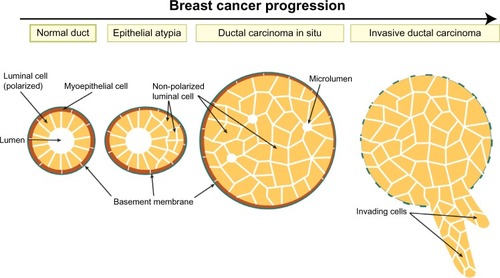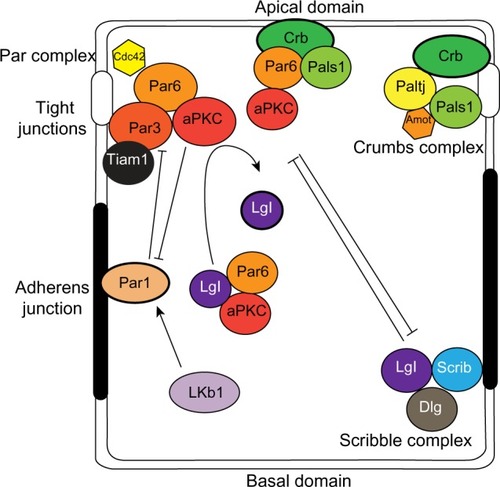Figures & data
Figure 1 Breast tumor progression.

Figure 2 Polarity complexes in epithelial cells.
Abbreviations: Amot, angiomotin; aPKC, atypical protein kinase C; cdc42, cell division control protein 42; Crb, Crumbs 3; Dlg, Discs-large; Lgl, lethal giant larvae; Lkb1, liver kinase b1; Patj, Pals1-associated tight junction protein; Scrib, Scribble.

Figure 3 Potential mechanisms by which normal epithelial organization can be lost early in the progression of breast cancer.
Abbreviations: EMT, epithelial-mesenchymal transition; MET, mesenchymal-epithelial transition.

Figure 4 Model for oriented cell division.
Abbreviations: aPKC, atypical protein kinase C; cdc42, cell division control protein 42; Dlg, Discs-large; E-cad, E-cadherin; LGN, Leu-Gly-Asn repeat-enriched protein; NuMA, nuclear mitotic apparatus protein; MT, microtubule; Gαi, guanine nucleotide binding protein alpha inhibitory 1.

Figure 5 Signaling pathways regulated by apical–basal polarity complexes.
Abbreviations: Bim, Bcl-2 interacting mediator of cell death; Crb, Crumbs 3; c-Jun, cellular Jun; ECM, extracellular matrix; HER2, human epidermal growth factor receptor 2; Jak, Janus kinase; JNK, c-Jun N-terminal kinase; Lkb1, liver kinase b1; MAPK, mitogen activated protein kinase; MMP, matrix metalloproteinase; PI3K, phosphatidylinositide 3-kinase; RhoA, Ras homolog gene family member A; Scrib, Scribble; Stat, signal transducer and activator of transcription; TGF, transforming growth factor.

Figure 6 Regulation of Hippo-Yap1/Taz signaling by polarity complexes. The apical Crumbs and lateral Scrib complexes can sequester Yap1/Taz and the Hippo pathway kinases to prevent proliferation in polarized epithelial cells (left). Loss of polarity inactivates the Hippo pathway and releases Yap1/Taz to enter the nucleus to regulate proliferation (right). The Crumbs complex can also regulate SMADs to sensitize cells to epithelial-mesenchymal transition.

